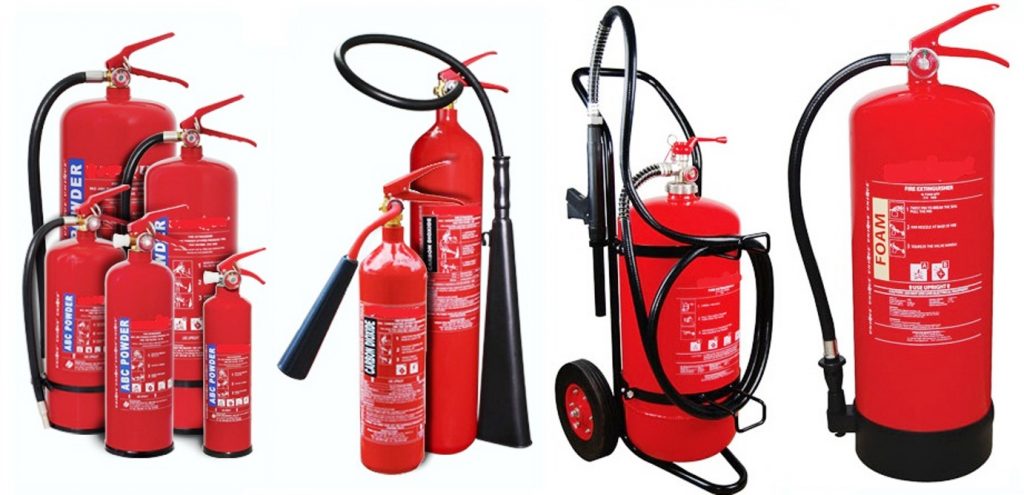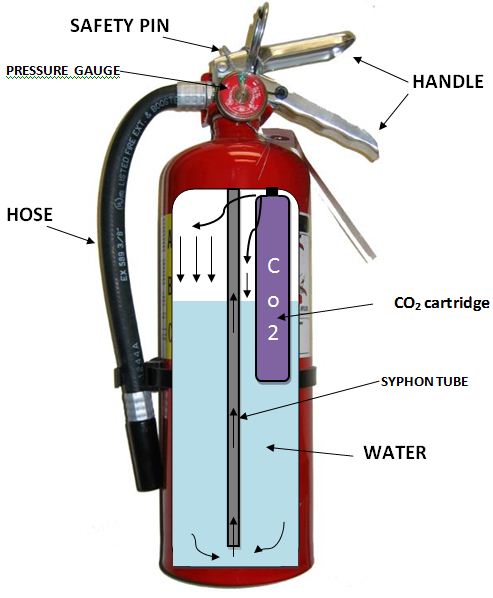OBJECTIVES:
After the completion of below lesson, you will be able to:
- Describe the types of fire prevention systems.
- Define portable fire appliances and their importance.
- Describe the types and function of portable fire appliances.
- Elaborate the classification, use and identification of fire extinguishers.
- Demonstrate the proper use of fire extinguishers.
- Describe the standard working and testing pressure of fire extinguisher.
- Elaborate the installation standards of fire extinguishers.
- Explain the care & maintenance of fire extinguishers.
- Describe the advantages of portable fire

Types of fire prevention:
The Fire prevention systems are mainly divided into 2 types which are as under:
- Portable fire appliances
- Fixed fire fighting installations
- Portable Fire Appliances:
These are portable appliances, installed on different locates i a building for immediate first response to small fires.
- Types Portables Fire Appliances:
- Fire sand /water bucket.
- Fire blanket.
- Gas/ smoke masks.
- Emergency Escape Breathing Devices.
- Fire extinguishers.
3.1 Fire sand/water bucket:
They are easy to use and can control the fire by smothering, cooling and breakdown of chain reaction action.
3.2 Fire blanket:
Fire blanket can suppress and control fire of burning person/appliance.
3.3 Gas/ smoke mask: evacuation or rescue
Operations to ensure the respiratory protection by providing filtered and purified oxygen/air for Respiration. See more about PPE or Personal protective equipments
3.4 Emergency Escape Breathing Device (EEBD):
It’s a self contained breathing device with its own limited air supply. It is only used for emergency escape from smoky, suffocating and toxic environment.
What is EEBD?
EEBD or Emergency Escape Breathing Device is a life saving appliance used for escaping an area with having hazardous conditions such as may be smoke, fire, poisonous gases etc in any place.
3.5 Fire Extinguishers:
A manually operated device/ apparatus usually made in form of metal container containing different extinguishing medium that can be discharged in rapid stream to extinguish the fire at its initial stage.
Parts & Section View of Fire Extinguisher:
Classification of Fire Extinguishers:
4.1 According to weight
Handheld type:
Capacity: 0.5 kg to 14 kg (01 to 30 lbs)
Trolley Mounted:
Capacity +23 kg (+50lbs)
4.2 According to propellant mechanism:
4.2.1 Stored pressure Type;
A fire extinguisher in which both the extinguishing agent and the expellant gas are kept in a single container. It is generally equipped with a pressure indicator or gauge.
4.2.2 Cartridge Type Fire Extinguisher;
A fire extinguisher that has the expellant gas in separate container from the extinguishing agent storage container. The storage container is pressurized by a mechanical action that releases the expellant gas.
4.3 According To Extinguishing Mediums:
- Water type.
- Foam type.
- Powder type.
- C02 Gas type.
- Halotron Gas type.
- Wet Chemicals type.
4.3.1 Water type:
Extinguishing Medium: Water
Driving Gas: Nitrogen
Suitable for: Class “A” Fires
Maximum effective range: 30-40 feet (2.5 gallon capacity)
Discharge Time: 60 seconds (2.5 gallon capacity)
Working / installation temperature: +04c to +60 c (Extinguishes by cooling burning materials.)
4.3.2 Foam type:
Extinguishing Medium: Foam + Water (03% + 97%)
Driving Gas: Nitrogen
Suitable for: Class “B” & “A” Fires
Maximum effective range: 20-25 feet ( 2.5 gallon capacity)
Discharge Time: 50 seconds (2.5 gallon capacity)
Working / installation temperature: +04 C to +60 C
(Extinguishes by Smothering & Cooling burning materials.)
4.3.3 Powder type:
Driving Gas: Nitrogen
Suitable for: Class A, B, C ( Dry Chemical Powders) & D (Dry Powders)
Maximum effective range: 05-20 feet ( 06 lbs to 30 lbs capacity)
Discharge Time: 10-25 seconds for (06 lbs to 30 lbs capacity)
Working / installation temperature: -20 C to +60 C
(Extinguishes by Break Down of Chain Reaction & Smothering burning materials.)
Note: Don’t mix Dry chemical powders with Dry Powders when you are going to use a Powder type fire extinguisher.
4.3.4 CQ2 Gas type:
Extinguishing Medium: Liquefied Carbon Dioxide
Driving Gas: Self Expelling
Suitable for: Class “E” Fires
Maximum effective range: 03-08 feet
Working / installation temperature: -18 C to +60 C
(Minimum 34% Concentration is required to Extinguish Fire and Extinguishes by Smothering & Cooling burning materials.)
Halotron Gas type:
Extinguishing Medium: Compressed Halotron 1 Gas (C2HCL2F3
Driving Gas: Self Expelling or Nitrogen (in case of HCFC Blend)
Suitable for: Class “C” & “E” Fires
Maximum effective range: 06-35 feet (1.4 lbs to 150 lbs capacity)
Discharge Time: 09-23 seconds for ( 1.4 lbs to 150 lbs) capacity
Working / installation temperature: -30 C to +60 C
(Extinguishes by Break Down of Chain Reaction & Smothering burning materials.)
Note: Halon type banned (1994) due to ozone depletion.
4.3.5 Wet Chemicals type:
Extinguishing Medium: Water + Wet Chemical / chemicals (Potassium acetate, Potassium citrate, Potassium carbonate)
Driving Gas: Nitrogen
Suitable for: Class “F” (Kitchen Fires)
Maximum effective range: 08-12 feet max.
Discharge Time: 75-85 seconds for 2.5 gallon
Working / installation temperature: +04 C to +60 C
(Extinguishes by Smothering / Saponification burning material (Cooking Oils)
4.4 How to identify a Fire Extinguisher:
Following techniques are used to identify a desired fire extinguisher:
- By Color coding.
- By Nozzle type.
- By Labeling.
- By Pictography.
How to Use a Fire Extinguisher:
- Making That “Right” Decision to use a Portable Fire Extinguisher”
- You are trained in the use of extinguishers.
- You know what is burning.
- Fire is not spreading rapidly.
- Smoke and heat has not filled the area.
- Have a clear path of escape
5.1 The P.A.S.S. Method:
P= Pull the safety Pin
A= Aim at the seat of Fire
S= Squeeze the Operating lever
S= Sweep side to side
6. Standard Working and Testing Pressure for Fire Extinguisher:
6.1 For all type Fire Extinguishers (except Co2 type):
Working/filling Pressure: 150 psi
Body Testing Pressure: 350 psi
6.2 For C02 Gas type Fire Extinguisher:
Working/filling Pressure: 744 psi
Body Testing Pressure: 3350 psi
- All Fire Extinguishers have Pressure Gauge to allow visual capacity check except C02 Fire Extinguishers.
- C02 Fire Extinguishers are checked by Weight.
Installation Standards for Fire Extinguishers:
Following installation standards should be followed for Fire Extinguishers:
- All buildings shall have one multipurpose (A,B,C) dry chemical powder fire extinguisher of 06 Kg for each 2000 square feet of floor area. All the departments and rescue 1122 mostly uses these types of fire extinguisher in their offices and vehicles.
- The maximum travel distance to a fire extinguisher shall not exceed 75 feet but for kitchen areas this distance is 30 feet.
7.1 Recommended Mounting Heights for Fire Extinguishers:
According to NFPA 10“standards for portable fire extinguishers”
- Fire extinguisher weighing (total weight) up to 40 pounds (18.14 kg) should be mounted so top of extinguisher not more than 05 feet above the floor.
- Fire extinguisher weighing (total weight) more than 40 pounds should be mounted so top of extinguisher not more than 03 feet above the floor.
- Bottom of the Fire extinguisher should be at least 04 inches above the floor.
Care & Maintenance of Fire Extinguishers:
Inspection:
According to NFPA 10”standards for portable fire extinguishers”, “an inspection is a quick check to verify that a fire extinguisher is available and ready for immediate use”.
Maintenance:
According to NFPA 10 standards for portable fire extinguishers, maintenance includes an internal inspection as well as any repair that may be required.
Following points are important of inspection and maintenance of the fire extinguishers:
- Extinguishers are at easy accessible height.
- Extinguishers are free from blocking by storage or equipment.
- Location of extinguishers is near normal path of travel
- Extinguishers are free from the potential of physical damage.
- Extinguishers are readily visible.
- Extinguishers are placed at its designated place.
- Operating instructions face outward.
- Operating instructions are legible.
- Type and size of mounting bracket is good and no problem to] de-mount the extinguisher, when needed.
- Discharge hose & nozzle clogged.
- Discharge hose is well tightened at valve outlet and has no” visible Cuts on its outer surface.
- Nozzle has not been removed from its place and is free of damage.
9. Advantages of portable fire appliances:
- Portable
- Use friendly for community.
- Available for various classes for fire.
- Economical
- Effective for small scale fire.

John Doe, a seasoned firefighter, shares his vast knowledge of fire safety and emergency preparedness at arescuer.com, aiming to empower and educate

